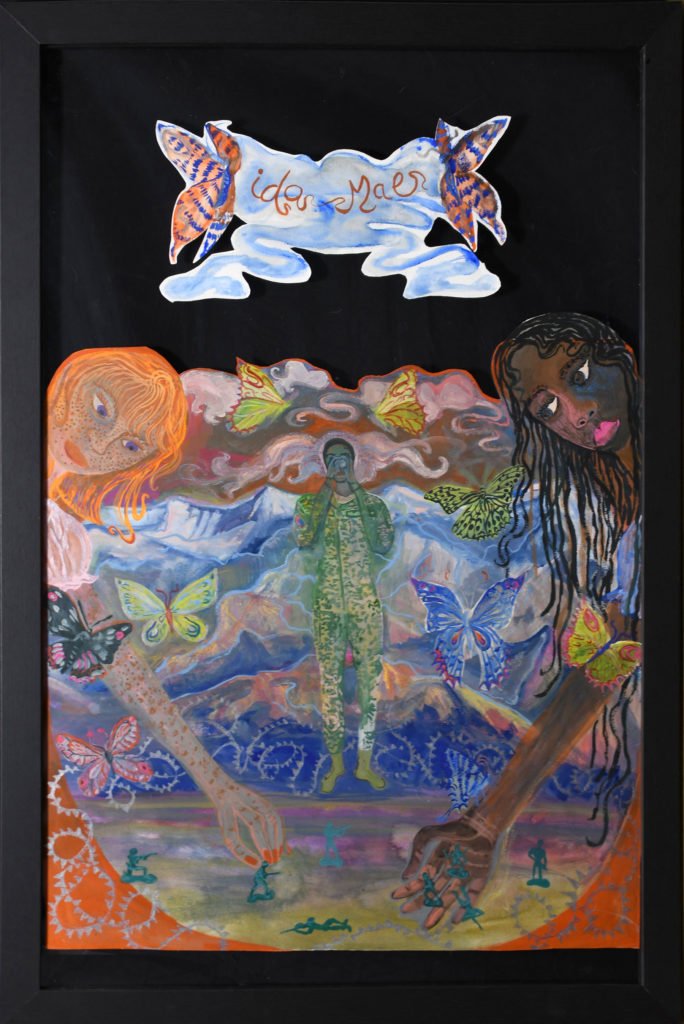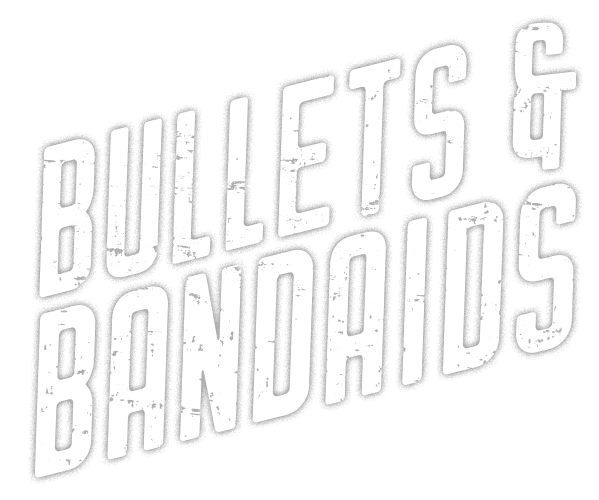
Lauren Chapman
26” x 40” • Framed Mixed Media on Paper
Ida was a junior soldier and photojournalist for the military. She joined in 2009 in order to find job security and work on paying off her student loans. At the age thirty she was able to pay off thirty thousand dollars of her debt. She was active five years and three years in the reserves. She spent eight years photographing soldiers and writing for the local news. She used her creativity to enhance her experience, “I loved photographing them training because I would just ride with the craziest soldiers and take pictures of them jumping out of humvees with the rifle in their hands and that’s always fun when you have like little kids trying to pretend the GI Joe training in the army.” Ida spent one year in Afghanistan, which sounded like a chilling experience. There seemed to be so much anxiety being on base and seeing soldiers leave in humvees and not make it back alive. Ida told herself, “This is what I have to do, and I’m going to make the best of it.” Ida is passionate about equal rights for women in the military, “Female veterans are very unique because the military wasn’t built for them. They have redefined the landscape of the military and I do think that our country, our military, the life of service members, is better because women who served demanded to be just considered like me in every way. I feel like that consideration has ripped the initial essence of what It means to be a soldier and destroyed it, women want equality.” Reading Ida Mae’s interview for Bullets and bandaids was eye opening. I loved how honest and humble Ida was retelling her experiences and now I feel a connection to her. Ida and I have a lot in common so I felt from the beginning it was the perfect match for me since my work is primarily inspired by female stories. She calls herself a horrible soldier who didn’t deal well with leadership. I found this interesting since she is an artist who now has a masters in painting. It was so cool reading what it was like being in such an authoritarian experience from the perspective of a creative person. Ida mentioned the butterfly effect and how women are adapting and overcoming in the military. For her piece I painted Ida in the middle of an Afghanistan inspired base. She holds her camera up pointed towards young women playing with military toys. The girls on each side represent the change happening currently in the military as women are aspiring more and more to serve their country. The butterflies represent Ida’s story. Her strength and growth as a veteran, an artist, and those she continues to inspire, myself included. Thank you Ida Mae for serving our country.
Inspired by the experiences of Ida Mae
Shooting War
by Dherick Jacobs
After getting a Bachelors in Fine Art, Ida Mae tried to get into the workforce in Georgia, but the money wasn’t there.
“I actually joined the military with a bachelor’s degree to pay up to go zero my student loans as well as have some type of career, because I was living in Georgia, and finding that all the jobs that I was being offered were at minimum wage or below,” Mae said. “I really did believe at the time I could find I could be, I could start my career and actually have a living wage.”
Mae then visited a recruiter looking to serve but specifically wanted something creative while serving her country. Mae joined the army as a photojournalist, and within a year, her $30,000 worth of debt was gone.
“I wouldn’t have been happy serving if I couldn’t be in somewhat creative,” Mae confessed. “I’d rather be doing things where my merit is judged on the things I create, but not off of my ability to follow instructions was the middle there is all about following instructions.”
“I was a horrible soldier,” Mae admits. “I didn’t deal with leadership very well. So I just, I just kind of got out of everything by just taking really, really amazing photos, really amazing photos, and trying to like, learn my camera. Right, really interesting stories go in, you know, interview really interesting people, and really focused on my craft, which was photography, and writing, and I really didn’t care too much about anything else that anybody had going on. And that’s kind of how I just kept my head down the entire time and did my job.”
Her work ethic became an asset during her tour in Afghanistan when stagnation could be a problem.
“And it just became like, kind of like this weird thing where we were just stuck in Afghanistan for a year, doing basically nothing but hanging out and trying to stay out of trouble, but not being occupied as like, not being occupied. They had nothing for all the soldiers to do.”
“I just tried to learn and work and network. Because I guess, to be stagnant for me, is to get in trouble. Because there were girls who got pregnant, there were girls who get raped. There are girls who, you know, got in, you know, gotten tons of just like drama and trouble. And I just wanted to like stay out of all of that nonsense. And so I just tried to make myself busy, because the alternative was just almost like here at home. If you don’t, if you’re not into anything that is positive, or even productive. A lot of times you just get caught up.”
During this time, Mae decided to be active in her work behind the lens. She used her time to write about her fellow service members, photograph everyone in her unit, and even take pictures for Christmas cards.
Despite times of stagnation, some moments resembled war.
“There was always rocket attacks,” Mae said. “There was, um, there was this incident where we were all sleeping and a rocket hit one of the male quarters and blew a hole into it. Or it was a suicide bomber who threw himself into a fence. And when he threw himself into the fence, he died immediately.”
When Mae finally got out in 2016 , she was becoming a first-time mother. The transition of leaving the military also made sure she remained creative in the process. Mae balanced doing design work, working at a jewelry store, and also working with the CIA. Her marriage took her to Virginia, and she continued as a staff writer for the Marine Corps.
The balance of military discipline, a creative mind, and being a Black woman all play equal footing with her as a creative.
“I really do think it’s important and is valid, that I’m like a black woman artist, but at the same time. I don’t always want that to be the foundation of what I’m creating. And so I think being in the military, it helped give me more help to help me be more mature. And help me Give me a better idea about about the world and give me more perspective as an artist. That doesn’t, there hasn’t seeped into my art yet. But I do think that it has made me a more mature artist. And it definitely has changed my perspective of my environment by expanding it outside of just what I’ve seen within the states or even my job in the military and the people I’ve had to interact with It’s helped me to be a lot more mature.”
“I deal with racism in a very weird way I deal with racism in a way that I accept it. And I wear inferior, inferior, being inferior, like it’s a jacket,” Mae said.
“But even today, I kind of like, I wear it a little bit, because I live in South Carolina, and I’m okay with racism. And I’m okay with it. Because I understand what it is. And I and I have a lot of sympathy for people who are racist. And I don’t try to change people. But I try to make sure that they don’t hurt me. And that’s why like, I wear it, like, I’m like, I just make sure that, like, I’m comfortable with the racism around me. And I think even in the military, I learned to be comfortable with racism, misogny, I learned to be comfortable with being treated, less than or not being heard or being overlooked. And I think that just growing up in Mississippi, made me the way I am to where I don’t like, I’m kind of like, kind of like getting where I fit in grower on planet and don’t complain too much about anything. And don’t even think that things are sometimes not even consider that things should be different.”
Even after serving, Mae understands the importance of staying creative and staying active artistically.
“I think it’s great and even like, in an abstract way, just showing that, that that change is still going on,” Mae said. “Sometimes in art, you can leave they there’s like, unfinished, that it’s that whole butterfly effect, like they’re still changed, this is going to be made, even after the art is made. And after we die, then whatever we do today is still going to be growing and changing because of our bravery, of starting something.”
